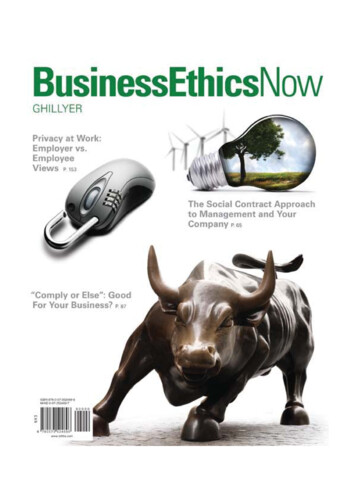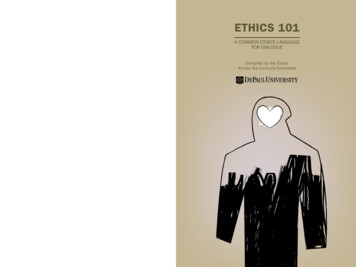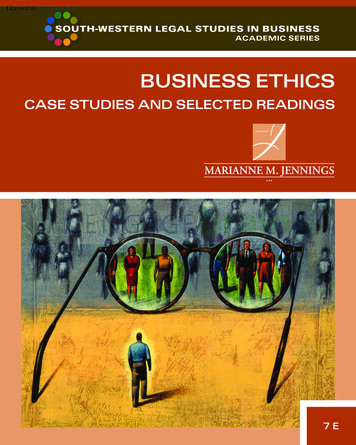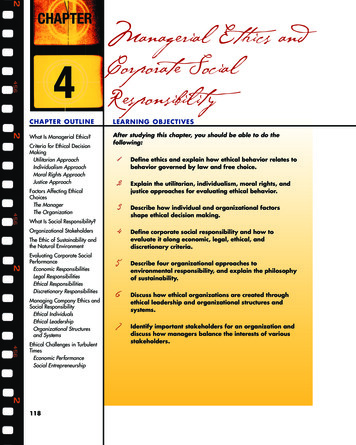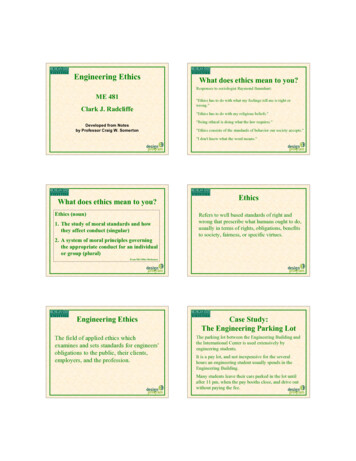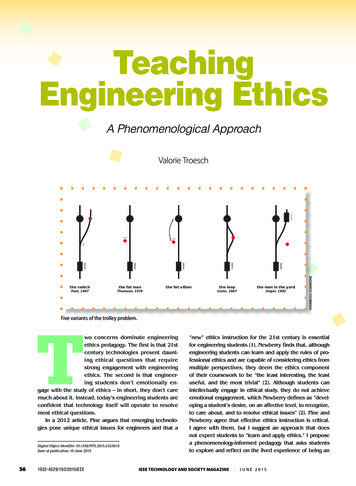
Transcription
TeachingEngineering EthicsA Phenomenological ApproachWikimedia CommonsValorie TroeschFive variants of the trolley problem.Two concerns dominate engineeringethics pedagogy. The first is that 21stcentury technologies present daunting ethical questions that requirestrong engagement with engineeringethics. The second is that engineering students don’t emotionally engage with the study of ethics – in short, they don’t caremuch about it. Instead, today’s engineering students areconfident that technology itself will operate to resolvemost ethical questions.In a 2012 article, Pine argues that emerging technologies pose unique ethical issues for engineers and that aDigital Object Identifier 10.1109/MTS.2015.2425615Date of publication: 19 June 2015561932-4529/15 2015IEEE“new” ethics instruction for the 21st century is essentialfor engineering students [1]. Newberry finds that, althoughengineering students can learn and apply the rules of professional ethics and are capable of considering ethics frommultiple perspectives, they deem the ethics componentof their coursework to be “the least interesting, the leastuseful, and the most trivial” [2]. Although students canintellectually engage in ethical study, they do not achieveemotional engagement, which Newberry defines as “developing a student’s desire, on an affective level, to recognize,to care about, and to resolve ethical issues” [2]. Pine andNewberry agree that effective ethics instruction is critical.I agree with them, but I suggest an approach that doesnot expect students to “learn and apply ethics.” I proposea phenomenology-informed pedagogy that asks studentsto explore and reflect on the lived experience of being anIEEE Technology and Society Magazine june 2015
ethical engineer. This instructional approach, which hasbeen pilot tested in the engineering classroom, could offeran alternative for 21st century ethics education that wouldemotionally engage our engineering students with ethics.Aristotle and the Nature of Knowledge:Engineering vs. EthicsTraditional engineering ethics pedagogy embodies adebate concerning the nature of knowledge that goes backto the ancient Greeks. In the Nichomachean Ethics VI,Aristotle sets up a taxonomy of knowledge that includesepistêmê, which is theoretical or scientific knowledge suchas mathematics and physics, knowledge that is universal and unchanging; technê, which is productive or craftknowledge characterized by the application of reason andused by people to design or do things – this includes arange of professions from artists to doctors to engineers;and phronesis, which is intelligence or practical wisdom,including ethics, with application to action taken in politics or the affairs of state [3]. Importantly, Aristotle distinguishes phronesis, from both epistêmê and technê. Thatis, he distinguishes ethical knowledge from both scientificand engineering knowledge, and he creates a dichotomy– objective, verifiable, and unchanging truth that standsat the top of the knowledge taxonomy, versus knowledgeand understanding as reflective, dialectic, and interpretivist– that has persisted through the millennia. This dichotomyhas a direct impact on how we teach engineering ethics.Much of traditional undergraduate engineering ethicseducation is premised on the assumption that, becausescientific and engineering knowledge are different fromand privileged over ethics knowledge, the only way tomake ethics understandable to engineering studentsis to teach it same way that engineering courses aretaught. This method would be with a linear, objective,positivistic, problem-solving approach that assumespure reason will yield correct, and often quantitativelydetermined, answers to ethical questions.This article contends that we first have to challengethe assumptions underlying this dominant educationalparadigm. Bunge, who is both a theoretical physicistand a philosopher of science, argues that technologyitself is not ethically neutral. He writes that “technologyis involved with ethics and wavers between good andevil” [4]. Second, he argues that we do a disserviceto both the profession and to society when we trainengineers and other technologists to be no more than“skillful barbarian[s] who must be kept in [their] modestplace as the provider[s] of material comfort” and whoare expected only “to carry on their task without beingdistracted by any ethical or aesthetic scruples” which areexclusively in the domain of management [4].In this article, I review the theories commonly usedin engineering ethics instruction and then introduce ajune 2015 phenomenology-based inquiry approach, its theoreticalfoundations, how it is used in the classroom, and myresearch on student learning outcomes. The phenomenological methods are intended to supplement and notsupplant ethical theory.Three Traditional Theories of(Engineering) EthicsThe three most taught ethics theories are deontologicalor rules-based ethics, consequentialist (utilitarian) ethics, and Aristotelian virtue ethics. Kant gave us the paradigm of rules-based ethics, the Categorical Imperative:to act only according to that maxim by which you canat the same time will that it should become a universallaw [5]. The rules that govern “right” behavior are derivedthrough reason, they are universal, they are inviolable,and they apply without exception. Benjamin Constantposed the challenge of the “inquiring murderer:” shoulda person lie to a murderer who asks the location of hisintended victim? Kant’s stunning reply was that lyingabout the would-be victim’s location would violate themaxim of truth-telling and would be wrong [6].The National Society of Professional Engineers (NSPE)has given us rules for engineers - the NSPE Code of Ethics. The rules are prescriptive, telling engineers howthey “shall” conduct themselves professionally. All myengineering students can recite Canon 1 of the NSPECode of Ethics: “Engineers, in the fulfillment of theirprofessional duties, shall hold paramount the health,safety, and welfare of the public” [7]. Some studentsunderstand this rule as clear-cut, absolute, and inviolable. In their view, nearly every professional engineering ethics decision can be unambiguously decided byreference to this Canon. But Davis [8] argues that professional ethics codes cannot be applied effectively withoutinterpretation.Act utilitarian ethics or consequentialism requiresthat we act in ways that will result in “the greatest goodfor the greatest number” [9], [10]. Consequentialismappears to be a pragmatic theory for ethical decisionmaking – we weigh the consequences of options and wepick the action that will do the most good or, in somecases, the least harm. Consequentialism is deceptivelysimple and is, in reality, a very complex and demandingway to live. Consider, for example, Peter Singer’s contemporary utilitarian argument that people living in affluentcountries have a moral obligation to commit all theirincome in excess of what they need to provide for theirown essentials to the cause of global famine relief [11].In engineering, “utility” often relies on a variety ofdecision-models such as risk analysis and cost-benefitanalysis to help engineering students quantify factorsto calculate the “right” decision. Although multiple factors may go into the calculation, students don’t see thisIEEE Technology and Society Magazine57
process as particularly challenging – it requires that aformula be applied to a set of facts in order to yield thecorrect answer. It is a familiar part of the design processfor which students are trained beginning from year onein Engineering Fundamentals.Virtue-based ethics receives increasing attention inengineering ethics education literature. Aristotelian virtueethics holds that the right action is that which a virtuousperson would do under the circumstances. Hursthousewrites that virtue as a character trait is “a well-entrenchedor settled state of a person – a certain sort of way theyare, through and through, all the way down – whichinvolves a disposition of a very complex sort” [12].Many scholars contend that virtue ethics offers greatpromise for developing the “emotional engagement”with ethics in engineering students. Harris arguesagainst “preventative ethics” – negative rules and disaster case studies – and for a “virtues ethics” in whichstudents create a “professional virtue portrait of thegood engineer” [13]. Stovall relies on Aristotelian phronesis and argues for a virtue of “self-awareness.” Hewrites that the “virtuous professional is the successfulprofessional” [14]. Pritchard [15] also argues against anover-emphasis on wrongdoing and disasters, and shiftsthe focus to questions of character of the “responsible”engineer, recommending that students study examples of exemplary engineering practice [16]. Frey offersan engineering ethics pedagogy grounded in moralpsychology wherein students study the competenciesneeded to be ethical and “practice moral expertise” inthe classroom [17]. Virtue ethics is used in professionalethics in addition to engineering, including medicine,law, and business. The Jubilee Centre’s website includesmany resources on virtue ethics education. [18]The method nearly universally employed to teachstudents how to use ethical theory is the case study.Case studies – real or fictitious – are plentiful: the spaceshuttle Challenger and Columbia disasters, the HyattRegency skywalk collapse, the Bhopal chemical spill,and the made-for-the-classroom depictions of multipleethical dilemmas in films such as Henry’s Daughters[19]. The case study method offers variety in the classroom, including class or small group discussions, roleplay, debates, and essay responses.In 2000, Herkert described the state of engineeringethics education in the U.S.A., including the utilizationof case studies and codes of ethics [20]. Bucciarelli, writing in 2008, strongly criticizes this traditionalapproach because it treats engineering practice as“solitary, instrumental, mono-paradigmatic, materialistic, value-neutral, hard, certain and calculative” ratherthan as a profession where engineers must be preparedto address “the social, the organizational – even thepolitical – complexities of practice” [21]. Pine’s 201258article described innovations in ethics instruction thatare being introduced at a handful of universities but,commendable as these efforts are, the pedagogicalapproaches are predominantly traditional [1].With the abundance of literature on alternative engineering ethics pedagogy, why doesn’t actual engineeringethics pedagogy change? Herkert concludes that themost notable challenge in undergraduate engineeringeducation is the failure of engineering faculty to acceptresponsibility for teaching ethics [20]. If we expect engineering ethics pedagogy to change, then we must makethose changes meaningful to the people who will implement them in the classroom. Before we can emotionallyengage our students in ethics, we must first emotionallyengage the faculty who are teaching ethics. Although itis outside the scope of this paper, one possible benefitof having faculty use a phenomenological approach toteaching engineering ethics is that it may also increasetheir engagement.Phenomenology as a Pedagogical MethodMost proponents of alternative engineering ethicsinstruction aim to have students grasp the essence ofbeing an ethical engineer. They expect that this experience will make students care about ethics in a way thattraditional ethics instruction does not. For example,virtue ethicists ask students to identify the virtues of agood engineer [13], [15]. Bucciarelli argues that studentsneed to understand the complex world of the engineerbeyond the technical aspects of design work [21]. Lynchand Kline contend that engineering students need toexperience ethics in the “real world” rather than studyingabstract notions of codes and moral theories [22]. Phenomenology – the revealing and description of essencesof phenomena – can inform a pedagogical method thathelps students discover and experience what it is to bean ethical engineer.Phenomenology is particularly useful to study professional experience because “it tries to place a researcherin the perspective of the research participants in order tounderstand their experience and feelings, thus unveilingwhat it means, from their point of view, to be in the situation within the experience” of that professional person[23]. Phenomenology is a philosophy that studies essences [24], [25]. As a research method, phenomenologyseeks to discover and describe the essences of humanexperience in the real, everyday, lived world. By describing the essences of experiences, we aren’t seeking theirscientific, theoretical, or causal explanations. Rather, phenomenology describes an experience and interprets it toexpress a general understanding about its essence – whatis that experience about, what is its meaning [26], [27].Phenomenology as a pedagogical method for engineering ethics education is not untried or unreported.IEEE Technology and Society Magazine june 2015
Porra [28] introduced phenomenological methods tohelp students understand the values, forces, interests,and mechanisms in society that pose ethical questionsfor design engineers. Broome described an activityhe tried in an ethics workshop to prepare students forthe FEE licensing exam. He asked students to take theexam before he delivered his lecture. Then, also beforethe students received any instruction, Broome askedthem to take the exam again but, this time, to imaginethemselves as an “aged, highly mature person: a family member or some legendary character; someonewho exhibited great wisdom and caring for others.”The results were stunning: students generally failed orperformed marginally on the first exam but “maximizedthe examination” when they imagined themselves to bewise and caring [29].Wike, who adopts a values-based approach to teachingengineering ethics, describes values in phenomenological terms: “If, as I am claiming, the best way to talk aboutethics is in terms of values, then ethics is everywhere.Ethics isn’t ‘outside’ a technical practice; it is alreadythere. We just have to make it explicit” [30]. Lynch andKline closely describe a phenomenological approach toengineering ethics when they suggest that students focuson the everyday mundane ordinariness – the essence – ofengineering ethical decision-making [22]. These approaches share a common aim to help students understand – toexperience, describe, and empathize with – the real worldexperience of being an ethical engineer.I propose a phenomenology-informed curriculumthat can be used by engineering and non-engineeringfaculty to help students study ethical experience. Sadalaand Adorno used phenomenology methods to help student nurses understand the world of nursing on an isolation ward. They prescribe phenomenology as the mostappropriate way to investigate professional experiencebecause students will acquire “experience in a situationwhere they relate to an already given world, which isout there, into which they are launched and which theywill have necessarily to face” [23]. I propose placing mystudents in the shoes of the researcher and having themask the phenomenological question: “What is it to be anethical engineer?”Phenomenological research is a rigorous methodology[31]-[33]. My intent is not to train my students in phenomenological research but to apply some of the concepts toan engineering ethics pedagogy. Phenomenology employsthe concept of “bracketing” [24] or the putting aside ofbiases or assumptions associated with the phenomenon inorder to understand the essences of an experience. Severalprinciples from phenomenology research guide the designof assignments. [32]. First, the question: “what is it to be anethical engineer?” does not have a pre-known answer andno theory is put forth for students to test. Instead, inquiryjune 2015 is a subjective experience in which each student exploresthe phenomenon and discovers his or her own answerto the question. Second, the focus is on real engineers,real-world engineering practice, and the “everydayness” ofengineering work and ethical practice. Third, because thereare no fixed answers, ambiguity is expected and necessary.Becoming comfortable with ambiguity in a profession thatrejects that notion is part of the inquiry process. Finally, thisis an inductive rather than deductive process; questioning,reflection, and interpretation are the tools of discovery.Assignments are not prescriptive or rigid. The phenomenological inquiry approach allows an instructorto try a variety of assignments and to use studentperformance and feedback to gauge outcomes andmake revisions. I begin the course by introducing thethree course objectives: 1) to develop a working knowledge of the principles of ethical theory and how thesetheories connect to personal and professional decisionmaking, 2) to explore and articulate their understanding of what it is to be an ethical engineer, and 3) todemonstrate proficient communication skills.Course IntroductionReadingExcerpts from Bunge, Philosophical Inputs and Outputsof Technology [4]. Bunge explains that technology is notethically neutral and that engineers are not morally irresponsible professionals who operate in isolation, merelysolving design problems. Rather, engineers always havechoices about the good or evil of the technology onwhich they work, and society benefits when engineersuse their expertise to help make these decisions. To bean engineer is necessarily to be concerned with ethics.WritingWriting enables phenomenological reflection and understanding of lived experience [27]. My students writea brief introductory autobiography that asks them toreflect on their life (including internship or co-op) experiences, examine their values, and explain how they seethemselves as emerging engineers.Ethics and ValuesReadingWike, Professional Engineering Ethical Behavior: AValues-Based Approach [30]. Wike reinforces the pointraised by Bunge that engineers have ethical responsibilities that cannot be passed off to management. And sherejects the idea that engineers can rely on laws and codesof ethics for the answers to ethical problems in engineering practice. She offers instead a values-based approachto moral decision-making for engineering design.IEEE Technology and Society Magazine59
In-Class ActivitiesI do not assume any theoretical ethics knowledge of mystudents, so I think they need to have some groundingin ethical theory. My phenomenological methods areintended to supplement and not supplant ethical theory.I provide an overview of the three dominant ethicaltheories (deontology, consequentialism, virtue) and howEngineering students deem the ethicscomponent of their coursework to be“the least interesting, the least useful,and the most trivial.”they relate to engineering ethics. Then, I pose two ethicsproblems to the students. The problems posed are wellknown to ethicists but not necessarily to engineeringstudents: the case of the inquiring murderer (a problemof deontology) and the trolley problem (a problem ofconsequentialism: there is a runaway trolley and you canoperate the switch that will avoid the trolley killing fivepeople on the track, but by switching tracks, the trolleywill kill one person on the other track).Following this, I ask students to think about howethical decisions are actually made. If codes and rulesand utilitarian calculations of consequences have limited practical usefulness in ethical decision-making,then how do engineers make ethical decisions? Moststudents recognize that they rely on their “values” tomake decisions. What they do not think about, however,is how their values influence nearly every decision theymake, usually with ethical consequences.A set of three activities helps them think about values.First, I ask the students to recall what they ate (or didn’teat) for breakfast and then to think about why they madethose choices. What students discover is that even thesimple choices they make about breakfast are based ontheir personal values and often carry ethical implications.The second activity asks student to work in smallteams to consider the Canons of the NSPE Code ofEthics and to identify the values that are behind theserules. If they cannot rely on the NSPE Code of Ethics todefinitively answer professional ethical questions, thenwhy does it exist? Where did these rules come from?The third activity is also a team activity. Each studentis asked to reflect on the values that made him or herchoose engineering as a profession and the particular fieldof engineering. These three activities are inclusive ways tohave students begin to talk about values, to realize how60influential values are in all decision-making, and to understand how ethical consequences follow from values.Finally, I ask the students to consider a real-worldcase such as the Space Shuttle Challenger disaster.Students now understand the issues in the case froma values perspective rather than from a rules or consequentialist perspective, resulting in new questions,alternative possibilities, and perhaps otherwise unconsidered ethical options and obligations.The terms “values” and “virtue ethics” are often usedinterchangeably. Virtue ethics arises from the Aristotelian notion of the virtuous person and the virtues such aperson would possess. Aristotle is unwavering in his conviction that the virtuous person acts virtuously becausethat is who the person is. The virtuous person, as recognized by Aristotle, is exceedingly rare. Current writerswho advocate for a virtues- based approach to engineering ethics usually begin with Aristotle and then offer prescriptive, though rarely identical, lists of the virtues thata virtuous engineer would possess [13]-[15].A values-based approach to engineering ethics emphasizes human values, things that are important to and thatmotivate people [30], [34]. In this respect, values-basedethics resembles virtue ethics. But values cross all theoretical boundaries in ethics. As the in-class activities onvalues demonstrate, both deontological and consequentialist ethics are premised on complex sets of values,although the theories themselves seek to give universalguidance on right behavior without the need to explicitlyacknowledge or identify the values underlying them. Aspart of a phenomenological inquiry into what it is to bean ethical engineer, students discover and reflect on thevalues they think are important, rather than have thesevalues delivered to them as pre- packaged content.Engineer InterviewReadingDowney, Lucena and Mitcham, Engineering Ethics andIdentity: Emerging Initiatives in Comparative Perspective [35]. The authors interview engineers from France,Japan, and Germany and compare their cultural viewson what it is to be an ethical engineer. My students represent a diversity of cultures. The ability to work in a globalworkplace is now a requisite skill, and this reading offersa glimpse into how engineers in different cultures varyin their understanding of what it is to be an ethical engineer. The article opens a discussion of the cultural differences represented by the students themselves.Interview and WritingInterviewing is the principle method of phenomenological research [36]. Talking with a person to discover theessence of the experience being investigated is the bestIEEE Technology and Society Magazine june 2015
way to understand that experience. My students interview practicing engineers. Students develop interviewquestions focused on what is it to be an ethical engineer. Students report that this is the assignment theymost dread but also the one that, after they’ve done it,is the most meaningful to them. Talking to an engineerabout being an ethical engineer is, from all I gather, abeneficial one for both the student and the engineer.Technology and Being an Ethical EngineerReadingsReadings on ethical questions posed by technology areabundant, and I vary the reading assignments each term.Some that I have used include: Shraeder-Frechette, Technology and Ethics [37]; Manion, Ethics, Engineering,and Sustainable Development [38]; and Heidegger, TheQuestion Concerning Technology [39]. Readings shouldoffer wide-ranging views on ethics, technology, and therole of engineers in the development of technology.Heidegger is a classic if not an easy read. But his centralmessage is that the best way to come to terms with technology is to engage in continuous questioning so as notto become “enframed” by it. This reading is intended tohave students begin to develop the habit of questioning,not only technology, but their roles as citizen engineers.Individual Student MeetingsI meet individually with each student twice during thesemester to review their research plans and progressand to address concerns and questions. Students reportthat these meetings are helpful to keep them on trackand to give them feedback. I also get feedback aboutthe effectiveness of coursework.Final Research EssayThe capstone assignment is a research essay thatasks the students to use their work from the semester to address the question: what is it to be an ethicalengineer? The question requires an interpretivist [26]approach. They must describe how they interpret andunderstand the essences of what it is to be an ethicalengineer. Students are expected to refer to readings,interviews, and other sources.Quantitative and Qualitative ResearchThis project began as a hypothesis in my Engineering Ethics in Design course, a 1-credit undergraduate 3000-levelelective offered at Michigan Technological University. Iwondered if a phenomenological inquiry by the studentsinto the essence of what it is to be an ethical engineercould yield more satisfactory learning outcomes andgreater student engagement with the study of engineeringethics. In the fall semester of 2011, I offered the revisedjune 2015 Engineering Ethics course. To assess the effectiveness ofthe revised course, I selected the Defining Issues Test-2(DIT-2) as a pre-test during the first week of the semesterand a post-test at the end of the semester.The DIT-2 is a test of ethical reasoning developed byresearchers in the Center for the Study of Ethical Development. It is a multiple choice test that consists of a setof five (non-engineering) scenarios presenting variousethical dilemmas without obviously right answers. TheDIT-2 has a large national database. The DIT-2 gives twoprincipal scores, the P score and the N2 score, whichquantitatively measure the participants’ ethical or moralreasoning skills [40], [41]. The DIT (predecessor to DIT-2)and DIT-2 have their critics [42]-[44], and alternatives arebeing tried. Borenstein et al. developed the Engineeringand Science Issues Test (ESIT) that uses job-related ethical dilemmas from science and engineering, rather thanthe non-engineering- specific dilemmas of the DIT-2, tomeasure moral judgment [45], and researchers continueto develop alternatives tests to the DIT-2 that will accurately measure ethical sensitivity. Nevertheless, the DIT-2continues to be used by researchers to measure the ethical reasoning skills of engineering students [46] and theeffectiveness of engineering ethics instruction [47], [48].Therefore, my study uses the DIT-2.Table 1 shows the pre-and post-test results (P and N2scores) for students in ENT 3958 for each of the threesemesters in which the course was piloted. Those scoresare compared to results of the SEED project and the DIT-2national norms for college-aged students. (SEED - the Survey of Engineering Ethical Development – was a multi-yearresearch study funded by NSF and headed by PIs fromLawrence Technological University, California Polytechnic State University, and the University of Michigan. Thisresearch conducted a nationwide assessment of the ethical development of over 4000 undergraduate engineeringstudents from 18 institutions, including Michigan Tech.The DIT-2 was used to measure ethical reasoning skills.The study measured students’ ethical development acrossall undergraduate years without regard for whether students had studied ethics. SEED offers a broad snapshotof the current ethical development of U.S. undergraduateengineering students. 238 undergraduate engineering students from Michigan Tech participated in the study.) MeanN2 and P scores of students in ENT3958 showed statistically significant improvement in each of the three years.For example, in 2011, N2 scores increased by 23.40%; in2013, N2 scores improved by 26.62%; in 2014, N2 scoresimproved by 38.38%.There are limitations of the pilot study. First, thenumber of students in ENT3958 is small. Second, therewas no control group of students who studied ethicsusing a traditional engineering ethics curriculum and nocontrol group of students who took no ethics course atIEEE Technology and Society Magazine61
TABLE 1. Dit-2 Scores compared mtu, nsf seed, National Norms.DIT-2 ScoreENT 3958NSF SEED Project201120132014Pretest(n 20)Posttest(n 16)Pre-test Post(n 20)test(n 17)Pretest(n 13)Posttest(n 13)MTU(n 238)17 Otherinstitutions(n 3700)P Score30.135.7526.1031.2930.7743.3329.932.9N2 Score28.5935.2826.8233.9634.0847.1629.732.4all. However, because of the small number of studentswho enroll in this elective course (offered only onceper year), it hasn’t been practical to establish a controlgroup. This remains an option to be explored.Despite these limitations, what might these resultstell us? First, results are consistent from year to year.Second, they are statistically significant rather thanexplainable by chance. Third, these results confirm thatour engineering students are capable of ethical reasoning that is on par with and in excess of their peersacross all other majors and institutions. Fourth, thispedagogical approach in a 1-credit ethics course couldarguably make a difference in achieving student learning outcomes and engagement with the study of ethics.Finally, I will comment on the 2014 course
wo concerns dominate engineering ethics pedagogy. The first is that 21st century technologies present daunt-ing ethical questions that require strong engagement with engineering ethics. The second is that engineer-ing students don’t emotionally en-gage with the study of e

